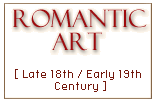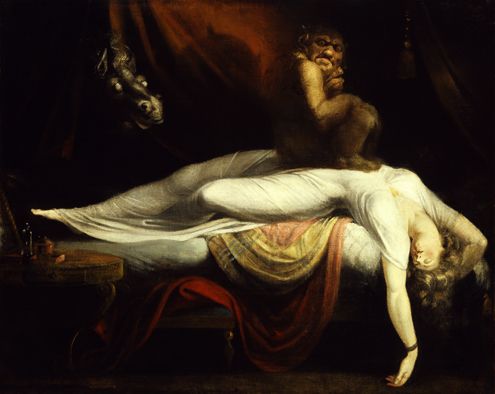
The Nightmare (1781)
by
Henry Fuseli (Johann Heinrich Füssli) (1741 - 1825)
Born in Switzerland but spending most of his adult life in England, Fuseli was associated with a "radical" group of cutting-edge Romantic writers and thinkers, and became an influential proponent of key Romantic ideas. His explorations of the dark areas of the psyche are evident in this, his most well-known painting today, The Nightmare. Fuseli was a good friend of the Romantic poet and painter William Blake, who once wrote that Fuseli was "The only man that e'er I knew / who did not make me almost spew." Another Romantic poet, the now-obscure Henry Kirke White, identified Fuseli as the "Genius of horror and romantic awe."
Here's one of the alternate versions of The Nightmare; this painting was so popular Fuseli painted at least three versions of it.

This painting is sometimes referred to as The Incubus, an incubus being a male demon that visits women in the night for sexual purposes. In the 16th through 19th Centuries, "incubus" had a secondary meaning: "A feeling of oppression during sleep, as of some heavy weight on the chest and stomach; the nightmare" (OED). Fuseli combimes both senses of the word here; the demon is crouched on the chest of the woman, creating that sense of a heavy weight; the woman's posture, one of exposure and vulnerability, is redolent of sexual possibility and violation. The picture was so popular Fuseli painted and sketched several versions. Much of his later work is notable for the presence of dark, often sexual, undertones; upon his death, his wife burned a number of his erotic drawings which had never been intended for public release. In this exploration of the darker corners of the human psyche, Fuseli had much in common with the Gothic novel (hugely popular during the Romantic period), as one commentator has noted: "Fuseli's ghostly and frightening subject-matter was a visual continuum of the Gothic novel, which developed an aesthetics of terror and horror, was occupied with dreams and the unconscious, and often looked back to the feudal world. Fuseli once said, that 'one of the most unexplored regions of art are dreams and what may be called the personification of sentiments.' However, Fuseli himself showed little interest in dreams and inner workings of the psyche, with one exception - like the Romantic writers Thomas De Quincey and Samuel Taylor Coleridge, Fuseli used opium." It may be no accident that the most famous Gothic novel of all, Frankenstein, has a climactic death scene which is directly based on Fuseli's painting.
Why a horse? Is it a visual pun? A (female) horse in the night is, after all, a NIGHT MARE.... and one of the oldest definitions of "mare," dating from the Middle Ages, is not a female horse but "A spirit believed to produce a feeling of suffocation in a sleeping person or animal; a feeling of suffocation experienced during sleep; an oppressive or terrifying dream" (OED). The horse is, thus, a visual pun that reinforces the sense of both terror and the surreal — and it's no accident that Fuseli's work was a significant influence on the Surrealist painters of the late Nineteenth Century.